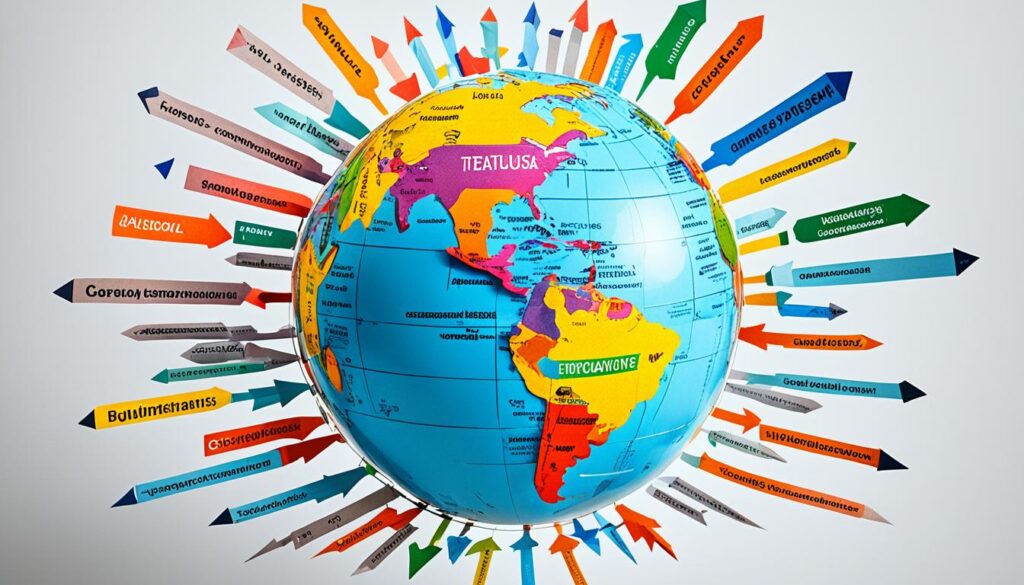
Expanding to a global audience is key for any business's growth. In today's digital world, multilingual SEO is a powerful tool. It lets you reach people around the globe by speaking their language.
Multilingual SEO focuses on translating your website into different languages. This is unlike international SEO which focuses on various countries. It involves choosing languages for translation, the translation process, and using hreflang tags to prevent duplicate content.
Trust signals are crucial in SEO content optimization. They boost your site's credibility, gaining confidence with search engines and users. A language-focused SEO strategy helps you offer top-notch, relevant content. This builds trust with your global audience.
Localization is about more than changing text. It means understanding cultural differences and local preferences. You also adjust things like units of measurement and currency formats. This way, you offer a user experience that feels personal to locals.
Multilingual SEO brings many benefits. It can increase your online visibility and attract organic traffic from various places. It also enhances user engagement and boosts conversions. By adopting a global search approach, you can grow internationally and reach more customers.
Key Takeaways:
- Multilingual SEO is the process of localizing a website into multiple languages.
- This approach puts focus on language to connect with diverse global audiences.
- It involves translating content, understanding cultural nuances, and adapting SEO elements.
- Trust signals and a language-led approach are crucial in multilingual SEO.
- Implementing multilingual SEO can expand your online visibility and engage with a global audience.
The Importance of Translation and Keyword Research in Multilingual SEO
In the world of multilingual SEO, getting translations and keywords right is key. Businesses want to be understood worldwide through their websites. So, translating and picking the right keywords for multiple languages is super important.
The Power of Accurate Translation
Good translation makes sure the message hits home for readers in their language. It's more than direct translation. It includes local sayings, cultural habits, and more. Doing this well helps boost a site's SEO and search rankings globally.
Using tools like Google Translate is okay to start. But for real accuracy, human touch is a must. Working with professional translators is the way to go. They ensure your content speaks clearly in every language.
Optimizing SEO Elements for Multilingual Websites
However, SEO for multilingual sites is not just about translation. It's also about tweaks in meta descriptions, title tags, and more for each language. This tweak helps the site perform better on search engines and gives users a great experience.
For SEO impact, include relevant keywords in all meta descriptions and title tags. Alt texts for images should also be translated well. This helps search engines understand the content better. It also makes the site more accessible to those who are vision-impaired.
And don't forget about internal links. They should work just as well across languages. This makes moving between different language pages smooth. A smooth experience keeps users happy and can lead to more interactions.
Good translation and smart keyword use make multilingual sites a hit. They bump up visibility, draw in more users, and please those who visit.

Translation and SEO Metadata Guidelines
| SEO Element | Translation Guidelines |
|---|---|
| Meta Descriptions | Accurately translate and optimize meta descriptions in each language. |
| Title Tags | Translate and adapt title tags to include relevant keywords in the target language. |
| Image Alt Texts | Translate image alt texts to provide context and increase accessibility. |
| Internal Links | Optimize internal links to ensure seamless navigation between language versions. |
Follow these strategies and you'll tap into your global audience. Your online presence will shine brightly worldwide.
Technical SEO Tips for Optimizing Multilingual Websites
Technical SEO is a big deal when you have websites in multiple languages. The way you set up your URLs matters a lot. You could use subfolders, subdomains, different domains, or URL parameters. Each has its own benefits for SEO and users. Picking the best one helps your site do better in searches.
Getting the content right is very important too. It should not just be translated well but also speak to the people reading it. Consider local customs, measurement units, and how currency is shown. This makes the content more relevant to your audience.
Using hreflang tags is another vital step. These tags tell search engines about your content in different languages. They make sure users land on the right language page after searching. Getting hreflang tags right improves the user's journey and stops SEO problems with copied content.
These tips can really boost your multilingual site's success. Having a clear URL structure, great translations, and using hreflang tags well are key. Take care with these details, and your site will connect with people from around the world.
FAQ
What is multilingual SEO?
Multilingual SEO means making your website in different languages. It focuses on the language, not just the location. This includes changing the content to different languages and using tags to manage that. This stops the same content appearing twice.
How does multilingual SEO differ from international SEO?
International SEO targets different countries. Multilingual SEO aims at diverse languages.
Why is high-quality translation important in multilingual SEO?
Good translations make your content better for the reader. It ensures your message connects well with different language speakers. This, in turn, helps your site do better in searches and reaches more people around the world.
What is the role of keyword research in multilingual SEO?
Keyword research helps find the right words for each language. It's key in making your site show up in more searches. By doing this, you can better target the audience in each language.
What are some technical SEO tips for optimizing multilingual websites?
For multilingual sites, focus on your URL setup. Make sure content is translated well and optimized. Also, use hreflang tags to manage content properly.










